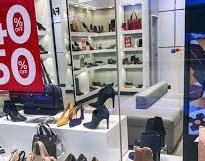How to maneuver in the recession driven by the COVID-19 pandemic, Russia's unprovoked invasion of Ukraine and the cost-of-living crisis: perspectives of the retail evolution’s great acceleration in the example of the UK, where booming clothes shops buck retail decline in February.
Could COVID-19 create a long-term shift in the retail industry? Learn more about pre-pandemic retail trends that are gaining momentum and how a recession could affect consumer behavior.
If we’ve learned anything from previous recessions, it’s that they expose existing weaknesses, accelerate emerging trends, and force organizations to make structural changes faster than they had planned. This is particularly true in retail. During the great recession of 2008–2009, e-commerce grew, and brick-and-mortar retail declined. As the economic recovery took hold, that trend continued while off-price, discount, and emerging players succeeded by appealing to new consumer demands.
We expect a similar pattern to follow—albeit with new trends shaped by a pandemic-driven global recession. Of course, certain truths remain: Retailers struggling before COVID-19 will likely see their declines accelerate. Income disparities will drive continuing business toward off-brand and discount retailers, and online shopping will continue to accelerate.
But we also see several other potential trends shaping the COVID-19 era retail environment:
- Product mix will likely change, and retailers will need to forge new partnerships to thrive.
- Consumer-retailer interactions will be defined by health and safety expectations.
- Demands for convenience will drive even more contactless transactions.
- Retailers will depend meaningfully on the trust they have with consumers and other stakeholders.
What is clear: Retail orthodoxies will be challenged, and the industry will likely look much different than when we entered this crisis. For now, the picture may appear bleak. But retailers who grasp the challenge and join the gathering trends could well emerge stronger and provide a brighter future for employees, customers, and stakeholders alike.
How does this recession compare to previous ones?
To best understand the impact of the current recession on retail, consider this: It’s very different than nearly all recessions that have come before it. The United States has experienced 22 business cycles since the beginning of the 20th century. All but three found their origins in financial markets. The “typical” business cycle has involved the overexpansion of credit, underpricing of risk, and eventual bursting of financial market bubbles.
By contrast, the COVID-19 recession was triggered by a sudden shutdown of consumer activity. People simply stopped eating out, traveling, and leaving the home. Roughly 40 million workers were furloughed or laid off as demand shut off and factories and offices were idled to prevent the spread of the virus. Some sectors, such as health care—which had proven virtually immune to recessions in the past—have shrunk as people have canceled doctor’s appointments and suspended plans for elective medical care.
Even consumers with jobs have stopped spending. Retail sales plunged 20 percent from February to April, with very large declines in categories like clothing and accessory stores (down 89 percent) and department stores (down 45 percent). The personal saving rate jumped to 33 percent in March from 8 percent in February. That’s likely the result of households with employed members cutting back on spending because there wasn’t anything to spend money on and because many households had good reason to wish to increase their savings in an uncertain time—rising saving rates are typical at the beginning of recessions.
Retail’s challenged position
Even before the COVID-19 crisis began, the DeLoitte report “The next consumer recession” found that retail was facing several financial issues that could make it difficult to weather a recession. Many retailers faced challenges already: increasing debt burdens, moderating revenue growth, compressing margins, increasing SG&A, and slowing asset turnover. Not surprisingly, we are starting to see these issues force several retailers to file for bankruptcy in recent weeks. But across retail, we are seeing significant weaknesses in the foundation: the technology and process architecture of retailers, often vulnerable to sudden shocks, are now completely exposed. Even many retailers that had been making incremental moves toward transformation have not been able to cope with the halt in store traffic, demand on digital, and shocks to the supply chain.
No matter the retailer, one cannot overstate the damage done when stores are closed for months at a time. Each regular customer represents a relationship that took years to develop and nurture and losing that continuity is a risk to any retailer’s position in the marketplace. The same is true with other stakeholders. Long-time employees, for example, have mastered what it takes to represent the brand over several years. Retailers are now having to create workforce flexibility, tools for secure collaboration, and positioning around furloughs, all while sustaining morale and keeping employees healthy. Even retailers who are faring well in the pandemic should take account of the damage done up and down their value chain and begin to develop strategies to restore what has been lost.
Trends gaining speed
During the first months of the COVID-19 crisis, there has been an acceleration of digital retail: Those retailers with strong platforms and sophisticated data analysis have succeeded in connecting with consumers and offering them additional services and value. Consumers are willing to embrace and explore new digital experiences due to public health concerns—telemedicine, online learning, virtual payments, and online grocery ordering and delivery. As the convenience of these experiences increases, we expect these trends to accelerate.
Before COVID-19, the convenience trend was being rewritten by players outside of the industry, putting pressure on the retail industry to adjust to reshaping consumer expectations. As the crisis hit, retailers have had to rapidly roll out conveniences such as buy online, pick up in-store (BOPIS), curbside pickup, and delivery. Those that have the systems in place to offer these conveniences have done comparatively better than others. DeLoitte survey “Global State of the Consumer Tracker” found from mid-April to mid-May that across age groups, the No. 1 reason customers chose BOPIS is because it is safer, followed by convenience.
What’s next for retail?
As retailers try to understand how to benefit from these accelerating trends while grappling with this crisis, let’s take stock of how certain retail orthodoxies have been turned on their heads:
- Direct interaction with shoppers, once the foundation of customer service, has been replaced by virtual or contactless touchpoints.
- Returns processing—likely to increase amid more online sales—will require new safety standards to meet customer expectations.
- Stores have turned into mini-fulfillment centers and pickup points.
- Supply chains are being restructured to fulfill specific orders to households rather than to large-format stores.
All of this calls for structural change in the industry. By challenging traditional orthodoxies, retailers can redefine the basic assumptions of the industry—how to build trust with stakeholders, how to operate stores in new ways, and how to structure their entire operations around new consumer expectations.
In the UK, booming clothes shops buck retail decline in February.
Customers turned back to shopping for clothes again in February as parties restarted and offices reopened following the easing of Omicron restrictions.
Data from the Office for National Statistics (ONS) shows that clothing sales jumped more than 13% during the month, bucking the overall trend across British retailers.
Overall retail sector sales dropped by 0.3% in February, down from a rise of 1.9% in January.
“After a buoyant January, retail sales fell back a little last month,” said Heather Bovill, ONS deputy director for surveys and economic indicators.
“There was a notable decline for companies that predominantly trade online, following a strong performance over the festive and New Year period.
“More socialising as well as many of us returning to the workplace meant a good month for clothing and department stores, with people looking to expand their wardrobes.
“Household goods and many other stores reported a decrease with feedback suggesting February’s stormy weather could have had an impact, while increased travel following the lifting of England’s Plan B restrictions at the end of January drove fuel sales above their pre-pandemic level for the first time.”
Sales are now 3.7% ahead of where they were at in February 2020, before the pandemic.
Food shops saw a 0.2% reduction in sales, especially in the alcohol and tobacco segments, which statisticians said could be down to more people going out to pubs and restaurants.
Sales of fuel for cars and other vehicles jumped by 3.6%, recovering to above its pre-pandemic levels for the first time, as more people travelled due to the lifting of restrictions.
Aled Patchett, head of retail and consumer goods at Lloyds Bank, warned that Russia’s unprovoked invasion of Ukraine and the cost-of-living crisis could pile pressure on the sector.
“The coming months are likely to prove disruptive for retailers,” he said.
“The impact felt from the cost-of-living crisis is expected to become particularly acute quite quickly.
“There is also the effect the conflict in Ukraine is having on certain supply chains, still struggling to recover from the strains of the last two years, and the uncertainty the situation creates for businesses.”
He added that normally during this time of year the high streets become busier ahead of the summer, but this time a dip in confidence could hammer retailers’ bottom lines.
“Rising energy prices pose a two-fold challenge to retailers, given they could both push up the day-to-day costs of running their business and hamper consumer spending power, in turn limiting the disposable income people have in their pockets and how much they spend on discretionary items.
“Add higher food prices resulting from the conflict in Ukraine, tax increases, the upcoming rise in the minimum wage and continued supply chain disruption to the mix, and it could prove to be a challenging period ahead.”


